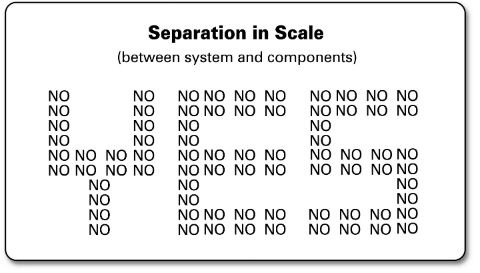Split Your Innovation Problem Four Ways: Separation Principles
Separation principles help when some physical contradiction stands between you and an innovation, and you need to resolve the conflict with minimal or no trade-off. For example, you need the water in the system to be hot for some functions but cold for others. Or you want all the information to make a good management decision, but you don’t want all the information because you don’t have time to sift through it.
Use the Separation Principles technique when you’ve identified a physical contradiction, and when other ideation techniques may have fallen short of resolving it. You may need the help of an expert to apply separation principles, depending on the nature of your innovation project and its difficulty level.
The separation principles come from the Theory of Inventive Problem Solving (TRIZ), and they are defined a little differently by different experts. For simplicity, we characterize the separation principles by separating contradictory properties in time, space, scale, and condition.
Steps to Apply Separation Principles
1. Identify the Physical Contradiction
The key action here is to figure out which variable, system, or part of a system conflicts with itself. If this is not readily apparent, identify what you want to maximize and why you also want to minimize or eliminate that factor as well. Here are some examples of physical contradictions:
- We need tire rotation to provide steering and to avoid skidding under icy or wet conditions that require extreme braking to stop the vehicle. But we don’t want tire rotation because the vehicle must stop.
- We need landing gear on planes for easy takeoff and landing, but we don’t want landing gear because it causes drag.
- Engineers want a large window in a spaceship to see out, but they don’t want the window because it adds extra weight to the spaceship.
- We want options when searching for flights online, but we don’t want options because they consume too much time to review.
2. Consider Separation Heuristics
The four separation principles—time, space, scale, and condition—can be applied in an endless number of circumstances. To help you determine which principle could resolve your physical contradiction, consider the following:
Separation in time: The strategy for this principle is that at Time 1, the variable has property (+P), and at Time 2 it has property (–P). For example, a modern fighter jet has to be maneuverable during landing as well as in combat situations. The requirements of the wing geometry are radically different in each scenario. At low speeds (Time 1) the best wing geometry is unswept (+P), while at high speeds (Time 2) it is swept (–P). These contradictory requirements are resolved through the invention of variable sweep wing geometry.

Separation in Space: The strategy for this principle is that at Place 1, the variable has property (+P), and at Place 2 it has property (–P). Classic examples of this principle include coffee pots, teapots, and thermos bottles. Taken further, this principle is at the heart of a new technology called holographic conferencing. Using this technology, for example, a holographic image of an executive in Bangalore, India, can be seen by an audience talking with another executive in San Jose, California. Both people have human properties in one space and holographic properties in the other space.
Separation in Scale: This separation strategy is applied to the system and its components, whereby the entire system has property (+P), and the component has property (–P), as illustrated in the exhibit. Another example is a chain, which is flexible at the system level but each link in the chain is rigid.

Separation Upon Conditions: This separation strategy entails that the system under Condition 1 exhibits property (+P), and under Condition 2, it exhibits property (–P). An excellent example is transitions lenses with a light-sensitive photochromic coating. The lenses are light or dark depending on the amount of UV radiation present.

3. Resolve Physical Contradiction
First, carry forward the contradictory element or characteristic of your physical contradiction from step 2. This is the characteristic X that must meet the self-opposing requirements.
Next, define the time period of the physical contradiction as:
- T1: before the event.
- T2: during the event.
- T3: after the event.
After this, complete logic statements A and B:
A: To (improve, retain) the useful action of (state the useful action), X must be (present, large, hot, etc.) during T (1, 2, or 3).
B: To eliminate the harmful action of (state the harmful action), X must be (absent, small, cold, etc.) during T (1, 2, or 3).
In statement A, X could be (present, large, hot, etc.), which means that in statement B, X would be (absent, small, cold, etc.).
Now, write the Physical Contradiction:
X must be ____________________ during time T____________________ and
X must be ____________________ during time T ____________________.
Then, choose a separation principle (time, space, scale, or condition) to apply and solve the contradiction.
Example of Separation Principles in Action
Scenario: In electroplating, the rate of deposition of metal is increased when the plating solution is warm. The shelf life of the solution, however, is reduced dramatically with the increased temperature. It is necessary to increase the rate of deposition with minimal degradation to the solution. How can this be done?
1. The Problem
The electroplating solution bath needs to be hot and cold.
The characteristic is temperature of the solution bath.
Time period is T1, T2, T3.
A. To increase the rate of deposition, the solution bath must be hot during T2 (actual electroplating).
B. To preserve the shelf life, the solution bath should be cold during T1 (before electroplating), T2, and T3 (after electroplating).
2. The Physical Contradiction
Solution bath temperature should be hot during time T2 (electroplating).
Solution bath temperature should be cold during time T1, T2, T3.
3. The Separation
Separation of opposite requirements in space
4. The Resources
Heat, space, equipment
5. The Solution
Heat the parts—temperature is hot at the interface, and cold everywhere else.
Additional Example—Manager Working in an Office
Manager Beth wants information so she can have control, but she doesn’t want information because she has too much already. Solution: Use periodic management reviews to separate the information in time.
Beth also needs to work on a critical project, but doesn’t want to work on a critical project because she has people tugging at her in the office. Solution: She works offsite for two days, thereby separating in space.
Beth is still overwhelmed with work so she co-opts several of her colleagues into taking on certain tasks. She has separated in scale to solve her problem. Some call this delegation.
To reduce the volume and complexity of issues due her attention, Beth requests that any item not affecting more than 20 people not be brought before her for consideration—she has separated in condition.
Resources
The TRIZ Journal is packed with resources, papers, and commentary. A quick search on the site for Separation Principles will yield some good information. Visit The TRIZ Journal.
This article was republished from The Innovator’s Toolkit: 50+ Techniques for Predictable and Sustainable Organic Growth co-authored by the Lean Methods Group CEO David Silverstein and Chief Innovation Officer Dr. Phil Samuel.

